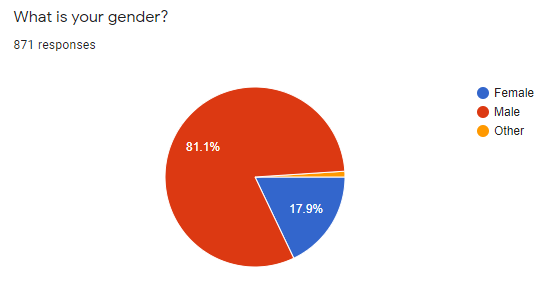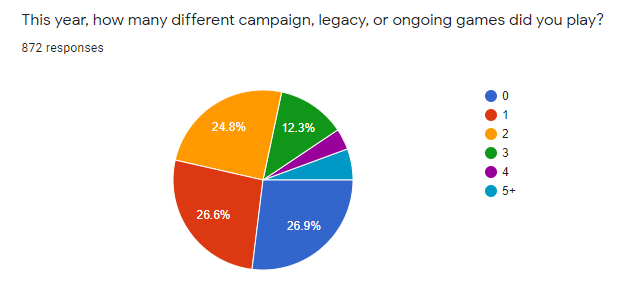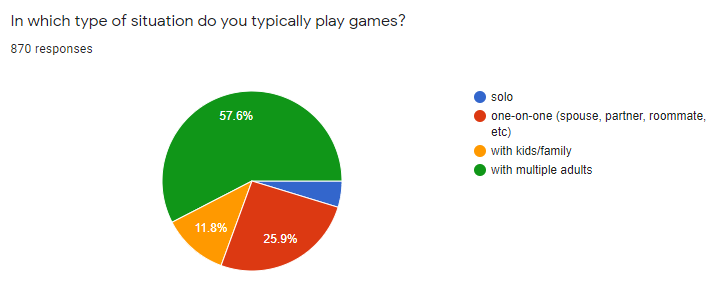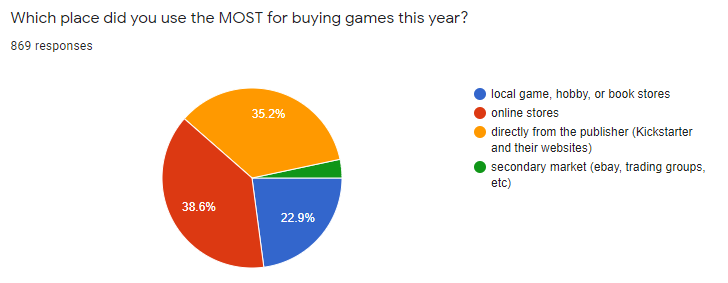Last week on the Stonemaier Games monthly e-newsletter (subscribe here), I shared a demographic survey with our subscribers. I’ve done this a few years in a row now, with the intent being to learn more about our followers. I tried to focus on questions with actionable results.
This year I’m really interested in comparing the results to previous years, so I’ll focus on data where a significant change has happened. First, two quick notes:
- A striking number of results were nearly exactly the same as last year’s survey, to the point that I often thought I was looking at the wrong pie charts. You can see my analysis of that data in last year’s post (the 2017 post is here).
- The motivator for filling out the survey this year was for Stonemaier Games to donate $1 per survey response to charity, whereas last year I gave a prize to a few random respondents.

Last year, 9.6% of respondents were female, but this year that number nearly doubled to 17.9%. While there are various reasons this could be, my biggest guess is that Wingspan appears to be far more popular to women than our other games. For example, 30% of the members of the Wingspan Facebook group are women, compared to 9% in the Scythe group.

Last year I theorized that while many gamers love the idea of campaign games–games that require multiple sessions to complete–they don’t actually play that many games in this genre because of the time and commitment level necessary to do so. If this theory is true, it would be a major deterrent for Stonemaier to publish campaign games in the future.
Last year, 31.8% of respondents indicated that they only played 0 or 1 campaign game in 2018. This year that number jumped to 53.5%. Perhaps this is more indicative of our subscribers than the general gaming audience, but to me it’s a strong indicator that campaign games should not be a priority for Stonemaier to produce in the foreseeable future.

While there wasn’t a huge difference in this data, it changed a bit compared to last year, with the main change being that 6% fewer people indicated that they play games with multiple adults and 4% more people said they play games one-on-one. Perhaps that’s indicative of a trend, as it is generally easier to find 1 person to play a game than 2 or more other players, but I’ll have to see if that audience continues to grow next year.

Per a suggestion from a reader of last year’s survey article, I added a new section to this question (“secondary market”). As it turns out, the results of that change weren’t significant–just 3.3% of people–but there was a pretty big increase in the number of people who typically buy from the publisher (35.2% this year compared to 27.2% last year).
Interesting to me is that all of those people seemed to shift over from those who buy from online stores (38.6% this year compared to 51.1% last year). In fact, the number of people who buy locally increased by 1% this year, reinforcing my opinion that publishers aren’t competing with friendly local game stores. Granted, this data only represents a microcosm of the overall gaming community.
***
What do you think about these differences between this year and last year? What are the reasons for these differences, and what can publishers learn from them?
If you gain value from the 100 articles Jamey publishes on his blog each year, please consider championing this content!
21 Comments on “5 Revelations from Our 2019 Demographic Survey”
Leave a Comment
If you ask a question about a specific card or ability, please type the exact text in your comment to help facilitate a speedy and precise answer.
Your comment may take a few minutes to publish. Antagonistic, rude, or degrading comments will be removed. Thank you.


[…] can see my analysis of previous years’ data here (2021), here (2020), here (2019), here (2018), and here […]
Hi Jamey, I love these demographic surveys. Do you share the raw data anywhere? I would love to do some correlation analysis on the variables over the years.
Thanks Jasper! We don’t share the raw data for this type of survey.
Would love to see how these have changed after the start of the pandemic. What the age ranges and other stuff is now. Hope you add all that and maybe some more detailed questions about interest in competitive vs cooperative. Maybe on “weight / complexity” of rules. And also how many have played games digitally (either through things like Tabletop Simulator, official games with multiplayer support, or other things). Maybe also something on digital hybrid tabletop games.
I was wondering the same thing. The pandemic has turned me into a solo gamer, whereas before I only played with groups. That has, to some extent, changed the types of games I’m purchasing. For instance, I’m *much* more interested in campaign & legacy now, as I know I can rely on myself to show up the next time I want to play! I’m guessing that the 2020 survey will show some big shifts.
I’m playing with a campaign game that’s more easily broken up into sessions, and aims to feel like the Star Trek universe — wade in anywhere to enjoy the game or a bit of lore, or dive deep to explore the whole universe. As a bonus, there’s also never a lock-in to the number of players (enemy strength is calculated according to the number of players), so it’s not like you’re waiting around for that fourth person to show up…
That there are more campaign games out there gives me pause… but I’m still quite convinced the experience will be unique / different from other campaign games (this is less for the hard-core gamer, simpler combat, some emphasis on story). Data is still important, of course, but it’s only part of the equation.
That sounds really cool, Chris! I’m taking a similar approach to my open-world game.
Great content, but I’m unable to discern the pie charts easily due to color vision deficiency. I realize this is a blog post, not a game with a budget, but a switch to bar graphs or different mix of colors (add black, white, grey; dump orange, green, purple; keep red, yellow blue) would make a big difference to those with the most common colorblindness types. Thanks!
Thanks! These are just screenshots of the pie charts Google Forms provides.
Yeah, understood. The “default” setting in Google, Microsoft, etc, is part of the problem.
I would suggest breaking down the purchase from Kickstarter and publisher section to their own parts.
I think you will find it’s mostly Kickstarter.
I personally this year only bought from 2 publishers web sites directly , yours and one other. The only reason I purchased from the other was the item they offered was only available directly from them. I’m a champion on your site and I have to say I’m very impressed with the entire process from announcement to ordering to shipping. It’s well worth paying the price of champion. I wish you could organize the rest of the publishers the same way.
While I understand that Kickstarter IS ordering from a publisher at well, and I’ve ordered at least 10 this year alone, I don’t feel like the experience is similar to ordering from an online store or from an online publishers site like your own.
Love the data.
Perhaps we could move the poll over to BGG to get more data.
Rich
I suggest the smaller count of legacy games played in a year is due to the smaller amount of legacy games available in general. Yes, the game night logistics are more of a commitment, but one worth making for an enjoyable game and often easily incorporated into existing gaming groups.
I further offer that legacy games, or a version of them, will see an increase in market share as more and more gamers seek something different but similar to the existing repertoire which is beginning to feel a little saturated (a new Epic Must-Have game appears every week on KS at this point and you can only paint so many miniatures)
What about a quasi-legacy game via a sidekick app with variable game counts? Or a Legacy “Lite” game which offers a simple (or not) mechanism for turning decisions and progress in a previous game into benefits for the next game? A Legacy game doesn’t need to have intricate plot lines and hyper balanced feedback systems, just something to make the game feel like it “counts” after the game has ended.
Which brings me to my biggest problem with Euro engine builders. Just as you’re ready to hit high gear, the moment you’ve build up to for 2 hours, the game ends. It has to. Every euro game I play leaves me with a “Just one more turn…” feeling no matter how well i performed.
A Legacy mechanism can alleviate this. And perhaps a Legacy mechanism is the next evolution in gaming? Or maybe not. But if theres one thing for certain, its that
I agree that there aren’t many legacy games, but the question was about campaign games (any game where you’re meant to play multiple sessions), of which there are quite a few. :)
Always good to see these. I’d suggest the spike in 2 player stats is related to the increase in Women playing, and more couples being a big part of that.
I really think the data surrounding the purchase avenue is interesting. I’d love to see a drill-down of this to see what type of game people are buying direct from publishers vs from retail outlets – if it’s mostly these big-box minis games, out of this is consistent across game-type.
As a note, although you may have some slightly skewed data based on the audience, >800 responses is still enough to draw reasonable conclusions from.
I think although these results provide great insights, you should not pay so much attention to them when you design new games. For instance I don’t usually play campaign games, but Fenris is one of the best games/expansions I’ve ever played. So I’d probable answer I don’t play campaigns. However I bought Fenris as soon as it was released and I love it.
Hi Christian, the analyst in me is twitching a bit at the idea of not using data to make a businesz decision. That is not to say that your experience isn’t completely valid. In the past year I have played one legacy type game, Pandemic. I bought the camp because I love pandemic. But I couldn’t find people to commit to playing it. So finally after two years, I told my husband we should just play it for ourselves. We had a fantastic time (and yes I died the first time we had to rip up a card).
So what are the takeaways?
1. People may purchase a legacy title because of the title not the legacy aspect. This sounds like both of our experiences, Christian.
2. People may also avoid legacy games because of needing to get people to commit. I would dig into how many people play legacy games with multiple adults versus a partner.
Small typo for “only” instead of “online”, but I almost interpreted it the exact opposite of your intent: “…who by from only stores (38.6% this…”
Do you think the Rise of Fenris last year shifted your data up from people playing one campaign to two last year, but now that they’ve finished, it’s back down to one?
Thanks for catching that, Josh! It’s certainly possible that The Rise of Fenris had an impact on that data.
May I suggest for next year forgetting about pie charts and maybe use bar charts as well as line progression charts from year to year? :-D
Here is a random, google-first-answer, page that talk about this: https://blog.funnel.io/why-we-dont-use-pie-charts-and-some-tips-on-better-data-visualizations.
Thanks! The pie charts are what Google Forms provides as an easy summary of responses, hence why I use screenshots of them for these posts.